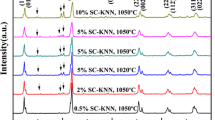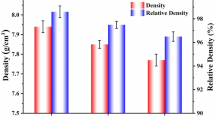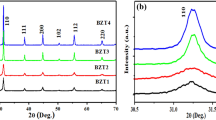Abstract
Sodium was used to substituted for potassium in Pb(Zr0.53,Ti0.47)O3–Sr(K0.25,Nb0.75)O3 (PZT–SKN) based on the lead-free (Na0.5K0.5)NbO3 (KNN) piezoelectric ceramic and a new ceramic material Pb(Zr0.53,Ti0.47)O3–Sr(Na0.25,Nb0.75)O3 (PZT–SNN) was developed in order to improve the humidity resistance. PZT–SKN and PZT–SNN ceramics have been fabricated by the conventional solid-state reaction method at the sintering temperature of 1,150–1,225 °C for 2 h. The effects of SKN and SNN on the microstructure, piezoelectric properties and humidity resistance of the prepared ceramics have been systematically investigated and compared. The phase structures of the two ceramics are both tetragonal. With increasing of SKN/SNN, both the grain size and Curie temperature decrease. Among all compositions studied, the 0.99PZT–0.01SKN and 0.98PZT–0.02SNN sintered at 1,175 °C exhibited optimal comprehensive properties. Especially, the PZT–SNN has a higher humidity resistance than PZT–SKN. The optimal values of d 33, kp, ε r and Tc for 0.98PZT–0.02SNN is 448pC/N, 0.63, 2,126.32 and 354 °C, respectively.






Similar content being viewed by others
References
M. Pereira, A.G. Peixoto, M.J.M. Gomes, Effect of Nb doping on the microstructural and electrical properties of the PZT ceramics. J. Eur. Ceram. Soc. 21, 1353–1356 (2001)
D.D. Wan, Q. Li, J.Y. Choi, J.W. Choi, Y. Yang, S.J. Yoon, Low-temperature sintered Pb(Zr, Ti)O3–Pb(Mn, Sb)O3–Pb(Zn, Nb)O3 for multilayer ceramic actuators. Jpn. J. Appl. Phys. 49, 071503 (2010)
L. Qiu, S.F. Yuan, X.L. Shi, T.X. Huang, Design of piezoelectric transducer layer with electromagnetic shielding and high connection reliability. Smart Mater. Struct. 21, 075032 (2012)
C.A. Randall, A. Kelnberger, G.Y. Yang, R.E. Eitel, T.R. Shrout, High strain piezoelectric multilayer actuators—a material science and engineering challenge. J. Electroceram. 14, 177–191 (2005)
N.J. Donnelly, T.R. Shrout, C.A. Randall, Addition of a Sr, K, Nb (SKN) combination to PZT(53/47) for high strain applications. J. Am. Ceram. Soc. 90, 490–495 (2007)
B.S. Li, G.R. Li, S.C. Zhao, L.N. Zhang, A.L. Ding, Characterization of the high-power piezoelectric properties of PMnN–PZT ceramics using constant voltage and pulse drive methods. J. Phys. D Appl. Phys. 38, 2265–2270 (2005)
F. Gao, L.H. Cheng, R.Z. Hong, J.J. Liu, C.J. Wang, C.S. Tian, Crystal Structure and Piezoelectric Properties of xPb(Mn1/3Nb2/3)O3–(0.2 − x)Pb(Zn1/3Nb2/3)O3–0.8Pb(Zr0.52Ti0.48)O3 Ceramics. Ceram. Int. 35, 1719–1723 (2009)
G. Helke, S. Seifert, S.J. Cho, Phenomenological and structural properties of piezoelectric ceramics based on xPb(Zr, Ti)O3–(1 – x)Sr(K0.25, Nb0.75)O3 (PZT/SKN) solid solutions. J. Eur. Soc. 19, 1265–1268 (1999)
D. Yuan, Y. Yang, Q. Hu, Y. Wang, Structures and properties of Pb(Zr0.5Ti0.5)O3–Pb(Zn1/3Nb2/3)O3–Pb(Ni1/3Nb2/3)O3 ceramics for energy harvesting devices. J. Am. Soc. 97(12), 3999–4004 (2014)
R.A. Langman, R.B. Runk, S.R. Butler, Isothermal grain growth of pressure-sintered PLZT ceramics. J. Am. Soc. 56, 486–488 (1973)
N. Kim, Grain size effect on the dielectric and piezoelectric properties in compositions which are near the morphotropic phase boundary of lead zirconate-titanate based ceramics, Ph.D. thesis, The Pennsylvania State University, 1994
C.A. Randall, N. Kim, J.P. Kucera, W.W. Cao, T.R. Shrout, Intrinsic and extrinsic size effects in fine-grained morphotropic-phase-boundary lead zirconate titanate ceramics. J. Am. Soc. 81, 677–688 (1998)
R.J. Brook, The impurity-drag effect and grain growth kinetics. Scripta Metall. 2, 375–378 (1968)
N.J. Donnelly, T.R. Shrout, C.A. Randall, Properties of (1 − x)PZT–xSKN ceramics sintered at low temperature using Li2CO3. J. Am. Soc. 91, 2182–2188 (2008)
R.B. Atkin, R.M. Fulrath, Point defects and sintering of lead zirconate–titanate. J. Am. Soc. 54, 265–270 (1971)
T.C. Che, C.S. Yuan, L.C. Hsien, Doping effects of Nb additives on the piezoelectric and dielectric properties of PZT ceramics and its application on saw device. Sens. Actuators A 113, 198–203 (2004)
M.N. Rahaman, Ceramic processing and sintering (CRC Press, Boca Raton, 2003)
G. Srivastava, A. Goswami, A.M. Umarji, Temperature dependent structural and dielectric investigations of PbZr0.5Ti0.5O3 solid solution at the morphotropic phase boundary. Ceram. Int. 39, 1977–1983 (2013)
K. Volkan, C. Ibrahim, T. Muharrem, Dielectric and piezoelectric properties of PZT ceramics doped with strontium and lanthanum. Ceram. Int. 37, 1265–1275 (2011)
M.M.S. Pojucan, M.C.C. Santos, F.R. Pereira, M.A.S. Pinheiro, M.C. Andrade, Piezoelectric properties of pure and (Nb5+ + Fe3+) doped PZT ceramics. Ceram. Int. 36, 1851–1855 (2010)
W.L. Zhang, R.E. Eitel, Low-temperature sintering and properties of 0.98PZT–0.02SKN ceramics with LiBiO2 and CuO addition. J. Am. Soc. 94, 3386–3390 (2011)
Volkan Kalem, Muharrem Timucin, Structural, piezoelectric and dielectric properties of PSLZT–PMnN ceramics. J. Eur. Ceram. Soc. 33, 105–111 (2013)
B. Jaffe, W.R. Cook, H. Jaffe, Piezoelectric ceramics (Amademic Press, NewYork, 1971)
H. Zheng, I.M. Reaney, W.E. Lee, Effects of strontium substitution in Nb-doped PZT ceramics. J. Eur. Ceram. Soc. 21, 1371–1375 (2001)
Vladimir Koval, Carlos Alemany, Jaroslav Briancin, Helena Brunckova, Dielectric properties and phase transition behavior of xPMN–(1 − x)PZT ceramic systems. J. Electroceram. 10, 19–29 (2003)
L.M. Zheng, J.F. Wang, C.M. Wang, Thermal stability and humidity resistance of ScTaO4 Modified (K0.5Na0.5)NbO3 ceramics. Chin. Phys. Lett. 26, 127701 (2009)
Acknowledgments
This work was financially supported by National Natural Science Foundation of China (11372133), NUAA Fundamental Funds (NS2013008), Fundamental Research Funds for the Central Universities (NJ20140012), The State Key Laboratory Program under Grant (MCMS-0514K01), A Project Funded by the Priority Academic Program Development of Jiangsu Higher Education Institutions (PAPD).
Author information
Authors and Affiliations
Corresponding author
Rights and permissions
About this article
Cite this article
Zhu, F., Qiu, J., Ji, H. et al. Comparative investigations on dielectric, piezoelectric properties and humidity resistance of PZT–SKN and PZT–SNN ceramics. J Mater Sci: Mater Electron 26, 2897–2904 (2015). https://doi.org/10.1007/s10854-015-2775-z
Received:
Accepted:
Published:
Issue Date:
DOI: https://doi.org/10.1007/s10854-015-2775-z




